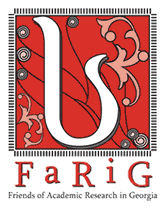Secular Tendencies in the 13th Century Murals of the Age of Queen Tamar
Maka Bulia
The decoration of the main church seems to be the most important of the surviving paintings at Natlismtsemeli Monastery. Fragments dating from various periods appear to convey the entire history of the monastery and its artistic creativity.
Made in 1205-1206 to mark the anointment of Lasha Giorgi, son of Tamar, as co-ruler, the paintings on the north and west walls depict the anonymous donor interceding with St Davit Garejeli and the representatives of the Bagrationi royal family, victorious kings of united Georgia from whom Lasha Giorgi inherited his throne: Davit Aghmashenebeli, Demetre I who once lived as a monk at Gareji, Giorgi III and Lasha Giorgi together with his royal parents, Queen Tamar and David Soslan. The first among the kings is Bagrat, who is referred to in the inscription as ‘the builder of Udabno’. This is most likely Bagrat III (975-1014), the first king of united Georgia. In 1010 he took hold of Kakheti, and thus of the Gareji monasteries. Thus it appears that the Church of the Nativity of St John the Baptist was hewn in rock and adorned with murals between 1010 and 1014. Of the original paintings, only ornamental floral strips survive in the jambs of the windows.
Being the descendants of David the Prophet, the Bagrationis asked the Saviour to forgive their sins with the intercession of their Biblical ancestors whose figures, set in ornamental scrolls, appear to separate the heavenly world from the earthly one. The huge scene of the Last Judgement took up the entire ceiling of the church, while the prophecy of the Second Coming and the Ascension of the Saviour, typical of early apsidal paintings of Gareji, appeared in the conch of the sanctuary. The scene of the Ascension symbolically recurs on the wall. Among the Holy Bishops the Ascension of Christ Emmanuel by angels is depicted. It is also echoed in an unusual iconographic version of the scene of the Forty Martyrs on the south wall, where the Holy Martyrs are shown before the enthroned judging Lord.
The theme of martyrdom and anchoretic life is widely represented. The entire lower row on the west wall shows the martyred warriors, while the south wall below the windows presents St Hermits. The top of the south wall and the jambs of the windows depict the life cycle of the patron of the church, the first martyr of the New Testament and the protector of hermits, St John the Baptist. The west and north vaults were adorned with the Great Feasts, of which only the scene of Palm Sunday survives.
The monumental figures of kings, as well as the abundant use of gold in their halos, crowns and rich attire, a decorative arcade encompassing all the representations of the church, numerous floral ornamental stripes, colours equal to the brilliance and dazzling of precious stones all combined to lend grandeur and extraordinary elegance to the entire painting. The ‘cosmic’ azure of the backgrounds created a sense of unity of the visible and invisible, as well as of eternity.
In the painting rigidly divided by ornamental stripes, balanced and placid scenes appear to be presented as separate pictures. Yet, the ‘arcade’ encompasses the entire church with a swift rhythm. The motion of thin, elongated figures, always free and elegant, is extremely expressive. The drawing forms a thin, refined contour around the figures. The drapery and separate forms within the outline are beautifully drawn, which adds to the impression of lightness and boldness. The combination of monumental figures, small scenes and extensive inscriptions suggest the use of illuminated manuscripts as a model.
The paintings from the period of Queen Tamar in Natlismtsemeli follow the Gareji painting tradition in terms of the iconographic themes, the use of manuscripts and the composition of a decorative system. However, the colour scheme and exceptionally refined rendering affiliate them with the so-called metropolitan samples. Considering that from the 12th century onwards the Gareji monasteries were royal, it is not surprising that invited artists worked alongside local painters for such an important royal commission. Among the churches built in the reign of Tamar, Natlismtsemeli probably best displays the artistic trends and the taste of the time. This painting harmoniously combines deep theological meaning with real historical events, the spiritual with the earthly.
The paintings covering the upper portions of the church were soon damaged and therefore were retouched at the end of the 13th century. Some differences can be observed between the original and later paintings. Specifically, the drawing became coarser, ochre came to be used excessively and a thicker coat of paint was used.
Maka Bulia